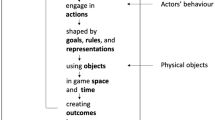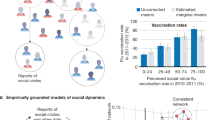Abstract
Over the past 100 years, social science has generated a tremendous number of theories on the topics of individual and collective human behaviour. However, it has been much less successful at reconciling the innumerable inconsistencies and contradictions among these competing explanations, a situation that has not been resolved by recent advances in ‘computational social science’. In this Perspective, I argue that this ‘incoherency problem’ has been perpetuated by an historical emphasis in social science on the advancement of theories over the solution of practical problems. I argue that one way for social science to make progress is to adopt a more solution-oriented approach, starting first with a practical problem and then asking what theories (and methods) must be brought to bear to solve it. Finally, I conclude with a few suggestions regarding the sort of problems on which progress might be made and how we might organize ourselves to solve them.
This is a preview of subscription content, access via your institution
Access options
Access Nature and 54 other Nature Portfolio journals
Get Nature+, our best-value online-access subscription
$29.99 / 30 days
cancel any time
Subscribe to this journal
Receive 12 digital issues and online access to articles
$119.00 per year
only $9.92 per issue
Buy this article
- Purchase on Springer Link
- Instant access to full article PDF
Prices may be subject to local taxes which are calculated during checkout
Similar content being viewed by others
References
Vickrey, W. Counterspeculation, auctions, and competitive sealed tenders. J. Financ. 16, 8–37 (1961).
Myerson, R. B. Optimal auction design. Math. Oper. Res. 6, 58–73 (1981).
Gale, D. & Shapley, L. S. College admissions and the stability of marriage. Am. Math. Mon. 69, 9–15 (1962).
Roth, A. E. & Sotomayor, M. in Handbook of Game Theory with Economic Applications Vol. 2 (eds Aumann, R. & Hart, S. ) 485–541 (Elsevier, 1992).
Merton, R. K. Social Theory and Social Structure 39–72 (The Free Press, 1968).
Hidalgo, C. A. Disconnected, fragmented, or united? A trans-disciplinary review of network science. Appl. Network Sci.http://dx.doi.org/10.1007/s41109-016-0010-3 (2016).
Becker, H. S. Tricks of the Trade: How to Think about Your Research While You're Doing it (Univ. Chicago Press, 1998).
Watts, D. J. Everything Is Obvious: *Once You Know the Answer (Crown Business, 2011).
Frank, R. H. Success and Luck: Good Fortune and the Myth of Meritocracy (Princeton Univ. Press, 2016).
Klinenberg, E. Heat Wave: A Social Autopsy of Disaster in Chicago (Univ. Chicago Press, 2015).
Venkatesh, S. A. American Project: The Rise and Fall of a Modern Ghetto (Harvard Univ. Press, 2002).
Goffman, A. On the Run: Fugitive Life in an American City (Picador, 2015).
Kahneman, D. Thinking, Fast and Slow (Macmillan, 2011).
Thaler, R. H. & Sunstein, C. R. Nudge: Improving Decisions About Health, Wealth, and Happiness (Yale Univ. Press, 2008).
Gelman, A. Red State, Blue State, Rich State, Poor State: Why Americans Vote the Way They Do (Princeton Univ. Press, 2008).
Milanovic, B. The Haves and the Have-Nots: A Brief and Idiosyncratic History of Global Inequality (Basic Books, 2010).
Ravitch, D. The Death and Life of the Great American School System (Basic Books, 2010).
Gruber, J. Covering the uninsured in the United States. J. Econ. Lit. 46, 571–606 (2008).
Banerjee, A. & Duflo, E. Poor Economics: A Radical Rethinking of the Way to Fight Global Poverty (Public Affairs, 2011).
Sunstein, C. R. Simpler: The Future of Government (Simon & Schuster, 2014).
Granovetter, M. S. Threshold models of collective behavior. Am. J. Sociol. 83, 1420–1443 (1978)
Bikhchandani, S., Hirshleifer, D. & Welch, I. A theory of fads, fashion, custom, and cultural change as informational cascades. J. Polit. Econ. 100, 992–1026 (1992).
Watts, D. J. & Dodds, P. S. in The Oxford Handbook of Analytical Sociology (eds Hedström, P. & Bearman, P. S. ) 475–497 (Oxford Univ. Press, 2009).
Bass, F. M. A new product growth for model consumer durables. Manage. Sci. 15, 215–227 (1969).
Kermack, W. O. & McKendrick, A. G. A contribution to the mathematical theory of epidemics. Proc. R. Soc. Lond. A 115, 700–721 (1927).
Goldenberg, J., Libai, B. & Muller, E. Talk of the network: a complex systems look at the underlying process of word-of-mouth. Market. Lett. 12, 211–223 (2001).
Strang, D. & Tuma, N. B. Spatial and temporal heterogeneity in diffusion. Am. J. Sociol. 99, 614–639 (1993).
Bicchieri, C. & Fukui, Y. The great illusion: ignorance, informational cascades and the persistence of unpopular norms. Bus. Ethics Quart. 9, 127–155 (1999).
Watts, D. J. A twenty-first century science. Nature 445, 489 (2007).
Lazer, D. et al. Computational social science. Science 323, 721–723 (2009).
Mason, W. & Suri, S. Conducting behavioral research on Amazon's Mechanical Turk. Behav. Res. Meth. 44, 1–23 (2012).
Horton, J. J., Rand, D. G. & Zeckhauser, R. J. The online laboratory: conducting experiments in a real labor market. Exp. Econ. 14, 399–425 (2011).
Paolacci, G., Chandler, J. & Ipeirotis, P. G. Running experiments on Amazon Mechanical Turk. Judgm. Decis. Mak. 5, 411–419 (2010).
Aral, S. & Walker, D. Identifying influential and susceptible members of social networks. Science 337, 337–341 (2012).
Bakshy, E., Eckles, D., Yan, R. & Rosenn, I. Social influence in social advertising: evidence from field experiments. In Proc. 13th ACM Conf. Electronic Commerce 146–161 (ACM, 2012).
Davis, G. F. What is organizational research for? Admin. Sci. Quart. 60, 179–188 (2015).
Wallerstein, I. Open the Social Sciences: Report of the Gulbenkian Commission on the Restructuring of the Social Sciences (Stanford Univ. Press, 1996).
Tetlock, P. E. Expert Political Judgment: How Good Is It? How Can We Know? (Princeton Univ. Press, 2005).
Gladwell, M. The tipping point. The New Yorker (3 June 1996).
Sampson, R. J. & Raudenbush, S. W. Systematic social observation of public spaces: a new look at disorder in urban neighborhoods. Am. J. Sociol. 105, 603–651 (1999).
Harcourt, B. E. & Ludwig, J. Broken windows: new evidence from New York city and a five-city social experiment. Univ. Chicago Law Rev. 73, 271–320 (2006).
Meehl, P. E. Why summaries of research on psychological theories are often uninterpretable. Psychol. Rep. 66, 195–244 (1990).
Collaboration, O. S. Estimating the reproducibility of psychological science. Science 349, aac4716 (2015).
Gelman, A. & Loken, E. The statistical crisis in science. Am. Sci. 102, 460 (2014).
Bush, V. Science: the endless frontier. Trans. Kansas Acad. Sci. 48, 231–264 (1945).
Stokes, D. E. Pasteur's Quadrant: Basic Science and Technological Innovation (Brookings Institution Press, 2011).
Sarewitz, D. Saving science. The New Atlantis 49, 4–40 (2016).
Shneiderman, B. The New ABCs of Research (Oxford Univ. Press, 2016).
Katz, E. & Lazarsfeld, P. F. Personal Influence: The Part Played by People in the Flow of Mass Communications (The Free Press, 1955).
Hallinan, M. T. Equality of educational opportunity. Annu. Rev. Sociol. 249–268 (1988).
Liberman, M. Fred Jelinek. Comput. Linguist. 36, 595–599 (2010).
Donoho, D. 50 Years of Data Science (Tukey Centennial Workshop, 2015); http://courses.csail.mit.edu/18.337/201/docs/50YearsDataScience.pdf
Prewitt, K. Can social science matter? Itemshttp://items.ssrc.org/can-social-science-matter/ (2016).
Judson, H. F. The Eighth Day of Creation (Simon & Schuster, 1979).
Author information
Authors and Affiliations
Corresponding author
Ethics declarations
Competing interests
The author declares no competing interests.
Rights and permissions
About this article
Cite this article
Watts, D. Should social science be more solution-oriented?. Nat Hum Behav 1, 0015 (2017). https://doi.org/10.1038/s41562-016-0015
Published:
DOI: https://doi.org/10.1038/s41562-016-0015
This article is cited by
-
Realizing the full potential of behavioural science for climate change mitigation
Nature Climate Change (2024)
-
A quasi-comprehensive exploration of the mechanisms of spatial working memory
Nature Human Behaviour (2023)
-
Top, mid-tier, and predatory alike? The lexical structure of titles and abstracts of six business and management journals
Management Review Quarterly (2023)
-
The Ground Truth program: simulations as test beds for social science research methods
Computational and Mathematical Organization Theory (2023)
-
Five years of Nature Human Behaviour
Nature Human Behaviour (2022)



